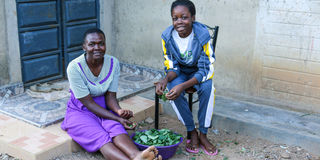When you get a donor but can’t afford the treatment

Karen Mukabi, a sickle cell patient, with her mother Eunice Yeswa at their home in Shikangania, Kakamega County, during the interview.
What you need to know:
- 90% - The success rate of a bone marrow transplant for matched sibling donor
- 80% - The success rate of a bone marrow transplant for matched family donor such as a parent
- 70% - The success rate of a bone marrow transplant for matched unrelated donor
When Karen Mukabi was diagnosed with Sickle Cell disease in 2007, it seemed as if her life was ending.
Then, as a seven-year-old girl, her parents did not know how to tackle the disease. From having to deal with recurrent infections, to regular hospital visits, their lives had become a nightmare. “She has had to go through a series of treatments, including blood transfusions, intravenous and intra muscular injections, among others,” explains her mother Eunice Yeswa, a high school teacher in Kakamega.
Apart from taking a toll on Karen’s body, these procedures have been draining the family’s finances. “The disease management is costly. It ranges from Sh1,500 to Sh55,000, depending on the number of episodes she experiences,” adds Yeswa.
The family hopes a bone marrow transplant will end this painful journey. “There is no treatment in Kenya. Doctors, as well as a friend whose daughter had a successful bone marrow transplant in India, advised me to consider this treatment,” she says.
Last month, Karen’s brother, who will be the donor, had a bone marrow match test.
Stroke attack
Although they are happy he is a match, they are worried about money. “We are expected to have more than Sh6 million for the bone marrow transplant in India. This amount is exclusive of other costs like transport and accommodation,” she adds.
It is the same predicament Florence Akata, 46, faced four years ago. Her daughter Marsha Toola, 13, travelled to India for a bone marrow transplant.
Then she was only eight years old and had been diagnosed with the disease at only eight months.
After a horrendous life of infections, countless blood transfusions, endless trips to hospital, and a stroke attack that left Marsha’s right side of the body paralysed, their paediatrician advised them to go for a bone marrow transplant in India.
It is a journey that would take them to Medanta Hospital in Gurgaon, India. After a 100 per cent donor match with her brother, Marsha went through the procedure that cost the family Sh7 million.
More than four years on, Marsha is doing well apart from the annual reviews in India, as well as physiotherapy on her right side of the body.
According to Prof Fredrick Asirwa, a medical oncologist and haematologist, although there are alternative affordable management treatments for sickle cell, haematopoietic stem cell transplantation is currently the only established cure.
Dr Satya Yadav, Director Paediatric Haematology Oncology & Bone Marrow Transplantation at Medanta Hospital, India, says: “All children with Sickle Cell anaemia offered Hydroxyurea and supportive care, mostly do well and do not need a transplant, but those who do not respond well to Hydroxyurea therapy, have no other choice.”
He adds: “The success rates are as high as 80-90 per cent. For matched sibling donor, the success rate is up to 90 per cent. For half matched family donor (sibling or parent), the success is 80 per cent, while the matched unrelated donor (donor from international registry), the success rate is up to 70 per cent.”
Despite its immense success rate, the transplant comes with a huge bill. To make matters worse, it is not available in Kenya, a fact that forces most patients to seek treatment abroad.
No registry
A National Assembly health committee report said more than 10,000 Kenyans travel abroad annually in pursuit of treatment, spending at least Sh10 billion. Cancer patients make up more than 50 per cent of Kenyans who seek treatment in other countries.
The number of sickle cell patients who travel abroad for bone marrow transplant is not clear. However, the number of patients diagnosed with the disease yearly paints a grim picture.
Prof Asirwa, also and the Director of International Cancer Institute, says in Africa, between 240,000 and 300,000 children are born with this haematological condition. “These are estimates because there is no robust registry. In Kenya, it is estimated that between 6,000 and 8,000 children are born annually with Sickle Cell. Unfortunately, up to 50 per cent of these children die before their fifth birthday due to complications from the disease,” he adds.
These figures are a clear indication of the dire need of bone marrow transplant services in the country.
Prof Constance Tenge of Moi University School of Medicine says such figures should challenge the Kenyan medical fraternity to invest more and ensure these services are available here. “We have to train our students, as well as get the equipment especially in public hospitals,” she says, adding that this could make treatment affordable.
Prof Asirwa says there is need to establish a bone marrow donor registry. “In the last 10 years, I have matched and sent 11 children with Sickle Cell for transplant to the US and India. Four of them underwent the transplant successfully. The rest were not able to get the transplant either due to lack of a matched-related or unrelated donor or the funds for this procedure,” he adds.



